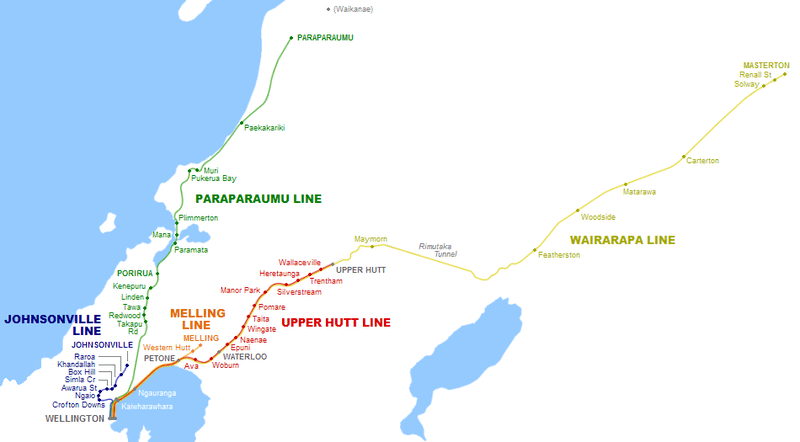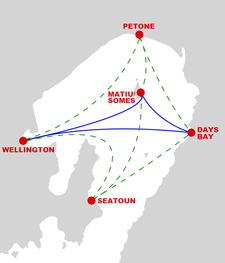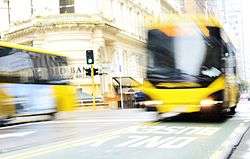Public transport in the Wellington Region
 | |
|
Buses in front of the Old Bank Arcade | |
| Locale | New Zealand |
|---|---|
| Service area | Wellington |
| Service type | Public transport in Wellington |
| Fuel type | Diesel, electricity |
| Operator | GO Wellington, Valley Flyer, Transdev Wellington, Mana Coach Services, Newlands Coach Services |
| Website | metlink.org.nz |
Public transport in the Wellington Region is well developed compared to other parts of New Zealand. It consists of Diesel buses, trolleybuses, Commuter trains, cars, ferries and a funicular (the Wellington Cable Car). It also included trams until 1964.
Buses and ferries are privately owned, with the infrastructure owned by public bodies, and public transport is often subsidised. The Greater Wellington Regional Council is responsible for planning and subsidising public transport, and pays around NZ$30 million for bus and train services each year.[1] The services are marketed under the name Metlink. The system covers Wellington city, Lower Hutt, Upper Hutt, Porirua, the Kapiti Coast and the Wairarapa.
System
Usage
According to the Regional Council,[2] over 36 million passenger trips are made by public transport in Wellington each year, and this number has been growing in recent years. The Wellington region has the highest per capita use of public transport in New Zealand,[3] with 70.91 trips per capita in 2013/14.
Of the approximately 36.41 million trips, around 24.10 million are made by bus, 12.13 million by train, and 0.18 million by ferry.
| Year | Bus | Ferry | Rail | Total patronage[2] |
|---|---|---|---|---|
| 2001/02 | 19,795,687 | 114,163 | 10,163,061 | 30,072,911 |
| 2002/03 | 20,711,898 | 117,027 | 10,010,448 | 30,839,373 |
| 2003/04 | 21,338,606 | 127,110 | 9,953,408 | 31,419,124 |
| 2004/05 | 21,902,604 | 137,844 | 10,253,811 | 32,294,259 |
| 2005/06 | 23,487,552 | 155,799 | 11,097,423 | 34,740,774 |
| 2006/07 | 22,794,990 | 156,718 | 11,175,993 | 34,127,701 |
| 2007/08 | 22,964,384 | 177,128 | 11,552,453 | 34,693,965 |
| 2008/09 | 23,381,247 | 179,981 | 11,875,820 | 35,437,048 |
| 2009/10 | 23,647,840 | 182,034 | 11,133,677 | 34,963,551 |
| 2010/11 | 24,026,904 | 176,581 | 11,202,227 | 35,405,712 |
| 2011/12 | 24,111,291 | 176,698 | 11,274,141 | 35,562,130 |
| 2012/13 | 23,607,936 | 192,549 | 11,355,403 | 35,155,888 |
| 2013/14 | 23,981,194 | 180,155 | 11,643,292 | 35,804,641 |
| 2014/15 | 24,098,765 | 179,106 | 12,128,995 | 36,406,866 |
Extent
The Regional Council's Regional Public Transport Plan[4] notes Wellington had:
- a rail network with 147 carriages, serving 53 stations
- a bus network with 470 buses (including trolleybuses) serving around 2,800 stops on around 108 routes
- two harbour ferries
- a five-station funicular, the Cable Car.
GIS information indicates that 77% of the region’s population lives within 800 metres of public transport stop with a 30-minute frequency or better.[5]
Wellington's hilly terrain has a considerable effect on public transport. Some planners consider Wellington to be a "good" city for public transport management, as the topography concentrates settlement in valleys or along coastlines, providing clear, dense "corridors" for transport routes. At the same time, however, the hilly terrain proved a hindrance for the construction of rail and tram lines, and buses sometimes have difficulty on narrow and winding streets.
Modes
Buses

Wellington has an extensive network of bus routes. Routes are determined by the Regional Council, which regulates commercially provided services and solicits bids from private operators to run the services it is prepared to subsidise. The largest operator is NZ Bus, which provides services for most of Wellington city under the GOWellington brand and for the Hutt Valley under the Valley Flyer and Runciman Motors brands. In Porirua and the Kapiti Coast most services are provided by Mana Coach Services, which also owns Newlands Coach Services, serving the northern suburbs of Wellington - Newlands, Johnsonville, Churton Park, Paparangi and Grenada North.
The majority of buses in the Wellington area are powered by diesel, but GOWellington has 60 trolleybuses that it operates within Wellington city. The trolleybus network was introduced between 1949 and 1964 to replace Wellington's trams (see below).
All GOWellington and Valley Flyer buses accept the contactless Snapper card. As of April 2011, GOWellington buses report real time location information which is displayed on electronic signs in some Wellington bus stops and can be viewed online.[6]
Trains

Transdev Wellington operates Metlink's five-line 154-kilometre (96 mi) Metlink commuter network, fanning north out of Wellington Railway Station, as far as Waikanae in the north and Masterton in the east. Transdev Wellington operates the service under contract to the Greater Wellingtion Regional Council with rolling stock (expect for diesel locomotives used on the Wairarapa services) owned by the council, and rail infrastructure owned by KiwiRail. Until 2016 KiwiRail division Tranz Metro had the contract to operate Metlink's services.
On average, 930,000 trips are made on Metlink trains each month.[2] In 2013-14, Tranz Metro claimed 94.3% punctuality, being the proportion of trains arriving within five minutes of schedule (94.7% punctuality if normalised for the effects of the 2013 Seddon earthquake and 2013 Lake Grassmere earthquake).[7]
From July 2016 Wellington's commuter rail services is operated by Transdev Wellington.[8] Transdev subcontracts KiwiRail to provide and operate the diesel locomotives on the Wairarapa services.
There are two major rail corridors in Wellington. The North Island Main Trunk runs along the western coastline, passing through Porirua and Paraparaumu to Waikanae on the Kapiti Coast (known as the Kapiti Line; the Wairarapa Line runs along the edge of Wellington Harbour and then up the Hutt Valley, passing through both Lower and Upper Hutt (known as the Hutt Valley Line. Less frequent services continue through the rural Wairarapa, stopping at a number of small towns before terminating at Masterton. There are also the Johnsonville Line in the north of Wellington and the Melling Line on the western side of Lower Hutt. Lines are double track except for a short stretch between Muri and Paekakariki on the NIMT and then north of Waikanae, the Wairarapa Line beyond Trentham, and the Johnsonville and Melling Lines, which are single track.

There are 49 stations in the rail network, all except Wellington Railway Station owned by Greater Wellington Regional Council. Wellington Station is the busiest by far, with trains arriving and departing every few minutes at peak times. The next busiest stations are Porirua, Waterloo (in Lower Hutt) and Johnsonville. Most stations are served by only one line.
Most trains are the FP class Matangi electric multiple units, in sets of two to eight cars, introduced from 2011. They displaced the older DM class English Electric units, the last of which were withdrawn from service in 2012, and the EM class Ganz Mavag units, the last of which were withdrawn from service in 2016. The Wairarapa line beyond Upper Hutt is not electrified, so Masterton services use diesel-hauled SW and SE class carriages.
There are long-distance trains to Palmerston North (the Capital Connection commuter train) and Auckland (The Northern Explorer). These are not part of the Wellington transport system.
History
Electric suburban services began in July 1938,[9] following the opening of the Tawa flat deviation of the North Island Main Trunk (NIMT). The Johnsonville Line, the former route of the NIMT out of the capital, was the first line to be electrified. By 1940 the NIMT (the present Kapiti Line) had been electrified as far north as Paekākāriki.
The Hutt Valley Line was electrified to Taita in 1953 to coincide with major state housing developments in the area. In 1954, the Wairarapa railway line was diverted between Petone and Haywards via Waterloo and Taita, with the old line truncated to Melling to form the Melling Line. Electrification was extended to Upper Hutt in 1955.
Also in 1955, the 9 km Rimutaka Tunnel between Upper Hutt and Featherston opened, bypassing the laborious Rimutaka Incline and reducing the travel time from Wellington to Featherston to just over one hour, and from Wellington to Masterton to one-and-three-quarter hours. The Wairarapa Connection service started nine years later, after morning and afternoon peak services started to exceed the 176-seat capacity of the diesel railcars then used.
The electrification was extended to Paraparaumu in 1982 and to Waikanae in February 2011 to coincide with the arrival of the new Matangi electric multiple units.
Services
| Metlink network | ||||||||||||||||||||||||||||||||||||||||||||||||||||||||||||||||||||||||||||||||||||||||||||||||||||||||||||||||||||||||||||||||||||||||||||||||||||||||||||||||||||||||||||||||||||||||||||||||||||||||||||||||||||||||||||||||||||||||||||||||||||||||||||||||||||||||||||||||||||||||||||||||||||||||||||||||||||||||||||||||||||||||||||||||||||||||||||||||||||||||||||||||||||||||||||||||||||||||||||||||||||||||||||||||||||||||||||||||||||||||||||||||||||||||||||||||||||||||||||||||||||||||||||||||||||||||||||||||||
|---|---|---|---|---|---|---|---|---|---|---|---|---|---|---|---|---|---|---|---|---|---|---|---|---|---|---|---|---|---|---|---|---|---|---|---|---|---|---|---|---|---|---|---|---|---|---|---|---|---|---|---|---|---|---|---|---|---|---|---|---|---|---|---|---|---|---|---|---|---|---|---|---|---|---|---|---|---|---|---|---|---|---|---|---|---|---|---|---|---|---|---|---|---|---|---|---|---|---|---|---|---|---|---|---|---|---|---|---|---|---|---|---|---|---|---|---|---|---|---|---|---|---|---|---|---|---|---|---|---|---|---|---|---|---|---|---|---|---|---|---|---|---|---|---|---|---|---|---|---|---|---|---|---|---|---|---|---|---|---|---|---|---|---|---|---|---|---|---|---|---|---|---|---|---|---|---|---|---|---|---|---|---|---|---|---|---|---|---|---|---|---|---|---|---|---|---|---|---|---|---|---|---|---|---|---|---|---|---|---|---|---|---|---|---|---|---|---|---|---|---|---|---|---|---|---|---|---|---|---|---|---|---|---|---|---|---|---|---|---|---|---|---|---|---|---|---|---|---|---|---|---|---|---|---|---|---|---|---|---|---|---|---|---|---|---|---|---|---|---|---|---|---|---|---|---|---|---|---|---|---|---|---|---|---|---|---|---|---|---|---|---|---|---|---|---|---|---|---|---|---|---|---|---|---|---|---|---|---|---|---|---|---|---|---|---|---|---|---|---|---|---|---|---|---|---|---|---|---|---|---|---|---|---|---|---|---|---|---|---|---|---|---|---|---|---|---|---|---|---|---|---|---|---|---|---|---|---|---|---|---|---|---|---|---|---|---|---|---|---|---|---|---|---|---|---|---|---|---|---|---|---|---|---|---|---|---|---|---|---|---|---|---|---|---|---|---|---|---|---|---|---|---|---|---|---|---|---|---|---|---|---|---|---|---|---|---|---|---|---|---|---|---|---|---|---|---|---|---|---|---|---|---|---|---|---|---|---|---|---|---|---|---|---|---|---|---|---|---|---|---|---|---|---|---|---|---|---|---|---|---|---|---|---|---|---|---|---|---|---|---|---|---|---|---|---|---|---|---|---|---|---|---|---|---|---|---|---|---|---|---|---|---|---|---|---|---|---|---|---|---|---|---|---|---|---|---|---|---|---|---|---|---|---|---|
Legend
| ||||||||||||||||||||||||||||||||||||||||||||||||||||||||||||||||||||||||||||||||||||||||||||||||||||||||||||||||||||||||||||||||||||||||||||||||||||||||||||||||||||||||||||||||||||||||||||||||||||||||||||||||||||||||||||||||||||||||||||||||||||||||||||||||||||||||||||||||||||||||||||||||||||||||||||||||||||||||||||||||||||||||||||||||||||||||||||||||||||||||||||||||||||||||||||||||||||||||||||||||||||||||||||||||||||||||||||||||||||||||||||||||||||||||||||||||||||||||||||||||||||||||||||||||||||||||||||||||||
The Metlink network consists of five lines totalling 160 kilometres (99 mi). All lines originate from Wellington Railway Station, at the northern end of the Wellington central business district.
Around 101 kilometres (63 mi) of the network is electrified at 1500 V direct current with overhead lines. The only part not electrified is the Wairarapa Line beyond Upper Hutt; as a result Wairarapa Connection trains are diesel-hauled.
Until 2001, Tranz Metro also operated the Capital Connection service between Palmerston North and Wellington. On the sale of 50% of Tranz Scenic to directors of the West Coast Railway (subsequently repurchased by Toll) it was transferred to Tranz Scenic (now KiwiRail Scenic), where it remains.
The five Metlink lines, from west to east, are:-
| Line | Frequency | Calling at | Notes | |
|---|---|---|---|---|
| Johnsonville (JVL) | 2 trains per hour | Wellington, Crofton Downs, Ngaio, Awarua Street, Simla Crescent, Box Hill, Khandallah, Raroa, Johnsonville | ||
| Kapiti (KPL) | 2 trains per hour | Wellington, Takapu Road, Redwood, Tawa, Linden, Kenepuru, Porirua, Paremata, Mana, Plimmerton, Pukerua Bay, Paekakariki, Paraparaumu, Waikanae | Some peak services begin/end at Porirua or Plimmerton | |
| Hutt Valley (HVL) | 2 trains per hour | Wellington, Ngauranga, Petone, Ava, Woburn, Waterloo, Epuni, Naenae, Wingate, Taita, Pomare, Manor Park, Silverstream, Heretaunga, Trentham, Wallaceville, Upper Hutt | Some peak services begin/end at Taita | |
| Melling (MEL) | 1 train per hour (no service weekends) | Wellington, Ngauranga, Petone, Western Hutt, Melling | ||
| Wairarapa Connection (WRL) | 5 trains per day (2 tpd weekends) | Wellington, Petone, Waterloo, Upper Hutt, Maymorn, Featherston, Woodside, Matarawa, Carterton, Solway, Renall Street, Masterton |
Rolling stock
Metlink's rolling stock consists of electric multiple units and diesel locomotive-hauled carriages.
Electric locomotive-hauled trains were withdrawn in 1988 on the retirement of the EW class electric locomotives, displaced by the EM/ET class Ganz Mavag units introduced in 1982. DM/D class English Electric" units have been withdrawn as they became uneconomical to operate. Several DM/D units were kept for peak services and the Johnsonville Line, where the loading gauge and braking capacity prevented the EM/ET units operating.
New carriages were introduced to the Capital Connection in 1998 and the Wairarapa Connection in 2007. They are ex-British Rail Mark 2 carriages, re-gauged and refurbished. They replaced NZR 56-foot carriages built between 1937 and 1943.
In July 2007, GWRC ordered 48 FP/FT Matangi units to increase capacity and replace the remainder of the 70-year-old DM/D units. The Johnsonville Line was upgraded in 2008 and 2009 to accommodate the Matangi units.
In 2008, several DM/D units were reintroduced on peak services as an interim measure until the Matangi units arrived. Six SE BR Mark 2 carriages were partially refurbished and introduced for express peak services, top-and-tailed by two refurbished EO class electric locomotives. The locomotives, built in 1968, were used in the Otira Tunnel until its de-electrification in 1997. An additional locomotive was refurbished for backup. Due to mechanical issues and the availability of new rolling stock, the EOs were withdrawn from service in 2011.[10] Slower-than-planned commissioning of the Matangi units and the unreliability of the EO locomotives saw Melling line services temporarily replaced by buses in April 2013 and the permanent removal of the penalty fare for Hutt Valley passengers on the Wairarapa Connection in the southbound direction. On the Johnsonville line in 2012, from 7 February until the introduction of the Matangi trains from 19 March, some peak period trains were replaced by buses because of a shortage of DM/D units.[11]
On 25 June 2012, the last DM/D units were withdrawn from service, just one week shy of 74 years since the first members of the class entered service. The SE carriages formerly used with the EO electric locomotives were fitted with toilets and reallocated to the Wairarapa Connection in July 2013 to ease rolling stock constraints.
KiwiRail provides three diesel-electric locomotives on a "hook-and-tow" basis to operate the Wairarapa Connection trains. Since July 2015, services have been hauled by the DFT class; before then, the DC class was primarily used.[12]
Future
There is a campaign to extend electrified commuter services to Otaki, following the extension of the Kapiti Line to Waikanae in 2011.[13]
Ferries

Only the western and northern shores of Wellington Harbour are heavily populated, and the trip between these population centres is often as quick along the coast as it is by water: demand for ferries has been lower than might otherwise be expected. Two ferry routes are operated by East by West, a private company: daily between central Wellington and Days Bay on the eastern coast, near Eastbourne, serving Seatoun at peak times from 3 April 2008; and the Harbour Explorer Excursion at weekends, also serving Petone and Seatoun. Off-peak and weekend sailings call at Matiu / Somes Island, a nature reserve.
Historically ferries also served Miramar, Karaka Bay, and Eastbourne proper. These routes were discontinued as road connections around the region improved.
There are also larger road and rail ferries that cross Cook Strait to the South Island. These are not part of Wellington's public transport system.
Cable Car

The Wellington Cable Car runs between the central city and the hill suburb of Kelburn. It is used by commuters travelling to and from work, by people travelling from the city to the Wellington Botanic Garden, and by students at Victoria University.
Despite its name, it is a funicular with two counterbalanced cars permanently attached to each other by a cable, rather than a true cable car, where the cars grip or release the cable as needed. The cable runs through a pulley at the top of the hill, driven by an electric motor. Originally the cable car was a hybrid between a true cable car and a funicular, but retained its name when it was converted to a full funicular.
It is owned and operated by Wellington Cable Car Ltd, a wholly owned subsidiary of Wellington City Council. Until 2007 it was operated under contract by Transfield Services, a private company. Unlike most other public transport in Wellington, it runs without subsidy.
Trams (historic)
Between 1878 and 1964 Wellington had trams[14] serving the western, eastern and southern suburbs, with the northern suburbs served by trains. The trams were replaced by buses or trolleybuses, and occasional calls are made for light rail to be reintroduced.
Following the 2010 mayoral elections, Mayor Celia Wade-Brown pledged to investigate light rail between Wellington station and the airport.[15][16]
References
- ↑ What Greater Wellington and the Government are doing
- 1 2 3 "Greater Wellington Public Transport Patronage -- Metlink". Greater Wellington Regional Council. Retrieved 17 March 2013.
- ↑ Greater Wellington Regional Council 10-Year Plan 2009-19 - Key Issues
- ↑ Greater Wellington Regional Council - Regional Passenger Transport Plan 2007 - 2016 Adopted August 2007
- ↑ Wellington Regional Land Transport Strategy target assessment March 2010
- ↑ Greater Wellington Regional Council - Real time information arrives
- ↑ "Wellington Metropolitan Rail 2013/14 Annual Report" (PDF). Greater Wellington Regional Council. 30 June 2014. Retrieved 24 July 2015.
- ↑ "Wellingtons trains to be run by French company Transdev after KiwiRail loses contract". The Dominion Post. 17 December 2015. Retrieved 21 January 2016.
- ↑ "Electric trains come to Wellington". New Zealand History online. 20 December 2012.
- ↑ "Railfan". 18 (1). Triple M Publications. December 2011. ISSN 1173-2229.
- ↑ "Reduced capacity on two peak services on weekday mornings". Tranz Metro. 7 February 2012. Retrieved 5 March 2012.
- ↑ Norman, Emily (2 July 2015). "Faster locos mean timely rides - council". Wairarapa Times-Age. Retrieved 24 July 2015.
- ↑ Nigel Wilson. "Raumati Station Now". Retrieved 2011-02-23.
- ↑ A Wheel on Each Corner, The History of the IPENZ Transportation Group 1956-2006 - Douglass, Malcolm; IPENZ Transportation Group, 2006, Page 12
- ↑ Nichols, Lane (18 October 2010). "Just how green will we go under Celia?". The Dominion Post. Retrieved 4 November 2011.
- ↑ "New mayor's dream ride". The Dominion Post. 1 November 2010. Retrieved 4 November 2011.
External links
| Wikimedia Commons has media related to Public transport in Wellington. |
